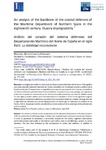Mostrar o rexistro simple do ítem
An Analysis of the Backbone of the Coastal Defenses of the Maritime Department of Northern Spain in the Eighteenth Century. Illusory Impregnability
| dc.contributor.author | García Hurtado, Manuel-Reyes | |
| dc.date.accessioned | 2022-05-04T08:15:30Z | |
| dc.date.available | 2022-05-04T08:15:30Z | |
| dc.date.issued | 2021 | |
| dc.identifier.citation | GARCÍA HURTADO, Manuel–Reyes, “Análisis del corazón del sistema defensivo del Departamento Marítimo del Norte de España en el siglo XVIII. La debilidad inconsciente”, en Investigaciones Históricas, época moderna y contemporánea, 41 (2021), pp. 551-588. DOI: https://doi.org/10.24197/ihemc.41.2021.551-588 | es_ES |
| dc.identifier.issn | 2530-6472 | |
| dc.identifier.uri | http://hdl.handle.net/2183/30595 | |
| dc.description.abstract | [Abstract] The election of Ferrol as the headquarters of the Maritime Department of Northern Spain in 1726 converted this small fishing village in Galicia into mainland Spain’s principal arsenal and shipyard. In order to guarantee its protection, a permanent concern for the Crown, engineers and seamen performed surveys and studies of the Galician coast with a view to establishing a system of coastal defenses. This was then followed by the construction of castles and batteries, in addition to watchtowers from which to monitor the coast and keep Ferrol informed of any developments by means of beacons. In the following pages, this system will be examined in order to determine its quality, efficiency, and state of repair during the eighteenth century, thus revealing the huge disparity between theory and practice. For, as with the rest of the Galician coast, Ferrol was continuously at the mercy of Spain’s enemies throughout the century. | es_ES |
| dc.description.abstract | [Resumen] La designación de Ferrol como sede del Departamento Marítimo del Norte en 1726 significó para esta pequeña población marinera de Galicia convertirse en el principal arsenal y astillero de la España peninsular. Para garantizar su seguridad, preocupación permanente de la Corona, se establece un sistema defensivo que determina el reconocimiento y estudio de las costas gallegas por ingenieros y marinos y la posterior construcción en las mismas de castillos y baterías, así como de edificios desde los que vigilar y realizar señales para transmitir todas las novedades a Ferrol. En las siguientes páginas diseccionamos la estructura defensiva para determinar su calidad, eficiencia y estado a lo largo de todo el siglo XVIII. Se evidencia una enorme distancia entre los planes que se elaboran y la realidad de los hechos. Ferrol, al igual que toda la costa de Galicia, estuvo a merced de los enemigos de España durante toda la centuria. | es_ES |
| dc.description.sponsorship | This work forms part of the project R & D of Knowledge Generation “Dinámicas y conflictividad en el litoral del Noroeste peninsular en la Edad Moderna” (FEDER, PGC2018-093841-B-C33), funded by the Spanish Ministry of Science, Innovation and Universities. | es_ES |
| dc.language.iso | eng | es_ES |
| dc.publisher | Universidad de Valladolid | es_ES |
| dc.relation | info:eu-repo/grantAgreement/AEI/Plan Estatal de Investigación Científica y Técnica y de Innovación 2017-2020/PGC2018-093841-B-C33/ES/DINAMICAS Y CONFLICTIVIDAD EN EL LITORAL DEL NOROESTE PENINSULAR EN LA EDAD MODERNA/ | |
| dc.relation.uri | https://doi.org/10.24197/ihemc.41.2021.551-588 | es_ES |
| dc.rights | Atribución-NoComercial 4.0 Internacional (CC BY-NC 4.0) | es_ES |
| dc.rights.uri | https://creativecommons.org/licenses/by-nc/4.0/legalcode.es | * |
| dc.subject | Ferrol | es_ES |
| dc.subject | España | es_ES |
| dc.subject | Defensa | es_ES |
| dc.subject | Costas | es_ES |
| dc.subject | Fortificaciones | es_ES |
| dc.subject | Siglo XVIII | es_ES |
| dc.subject | Spain | es_ES |
| dc.subject | Defense | es_ES |
| dc.subject | Coast | es_ES |
| dc.subject | Battery | es_ES |
| dc.subject | Eighteenth century | es_ES |
| dc.title | An Analysis of the Backbone of the Coastal Defenses of the Maritime Department of Northern Spain in the Eighteenth Century. Illusory Impregnability | es_ES |
| dc.type | info:eu-repo/semantics/article | es_ES |
| dc.rights.access | info:eu-repo/semantics/openAccess | es_ES |
| UDC.journalTitle | Investigaciones históricas. Época moderna y contemporánea | es_ES |
| UDC.volume | 41 | es_ES |
| UDC.startPage | 551 | es_ES |
| UDC.endPage | 588 | es_ES |
| dc.identifier.doi | 10.24197/ihemc.41.2021.551-588 |
Ficheiros no ítem
Este ítem aparece na(s) seguinte(s) colección(s)
-
II - Artigos [692]






